《中华医学》杂志投稿须知
- 格式:doc
- 大小:19.50 KB
- 文档页数:4
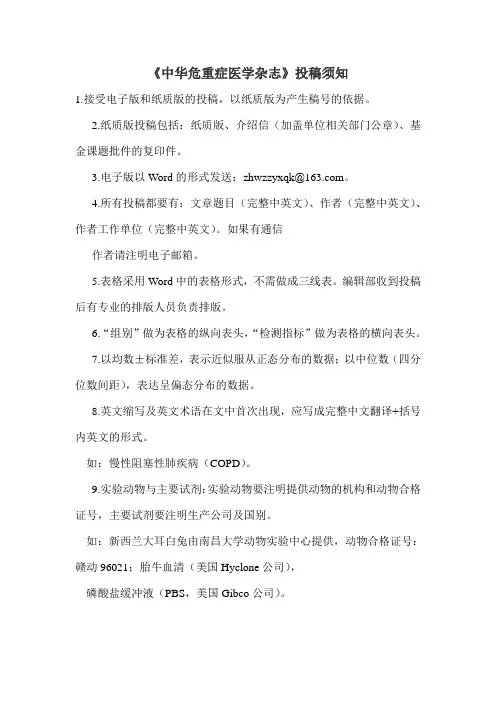
《中华危重症医学杂志》投稿须知
1.接受电子版和纸质版的投稿,以纸质版为产生稿号的依据。
2.纸质版投稿包括:纸质版、介绍信(加盖单位相关部门公章)、基金课题批件的复印件。
3.电子版以Word的形式发送:zhwzzyxqk@。
4.所有投稿都要有:文章题目(完整中英文)、作者(完整中英文)、作者工作单位(完整中英文)。
如果有通信
作者请注明电子邮箱。
5.表格采用Word中的表格形式,不需做成三线表。
编辑部收到投稿后有专业的排版人员负责排版。
6.“组别”做为表格的纵向表头,“检测指标”做为表格的横向表头。
7.以均数±标准差,表示近似服从正态分布的数据;以中位数(四分位数间距),表达呈偏态分布的数据。
8.英文缩写及英文术语在文中首次出现,应写成完整中文翻译+括号内英文的形式。
如:慢性阻塞性肺疾病(COPD)。
9.实验动物与主要试剂:实验动物要注明提供动物的机构和动物合格证号,主要试剂要注明生产公司及国别。
如:新西兰大耳白兔由南昌大学动物实验中心提供,动物合格证号:赣动96021;胎牛血清(美国Hyclone公司),
磷酸盐缓冲液(PBS,美国Gibco公司)。

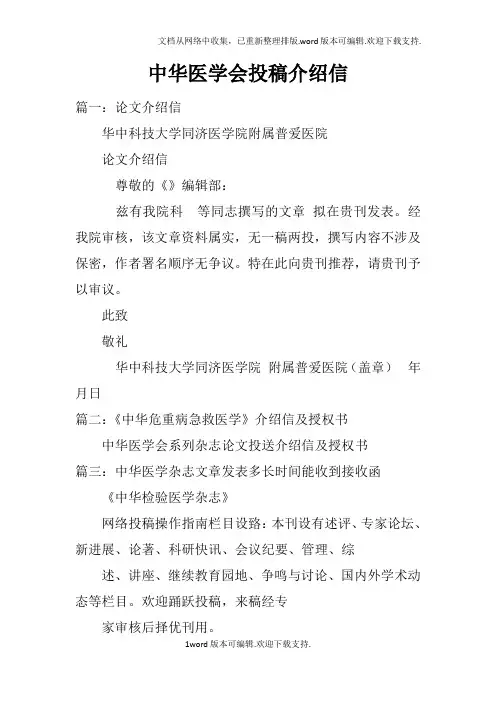
中华医学会投稿介绍信篇一:论文介绍信华中科技大学同济医学院附属普爱医院论文介绍信尊敬的《》编辑部:兹有我院科等同志撰写的文章拟在贵刊发表。
经我院审核,该文章资料属实,无一稿两投,撰写内容不涉及保密,作者署名顺序无争议。
特在此向贵刊推荐,请贵刊予以审议。
此致敬礼华中科技大学同济医学院附属普爱医院(盖章)年月日篇二:《中华危重病急救医学》介绍信及授权书中华医学会系列杂志论文投送介绍信及授权书篇三:中华医学杂志文章发表多长时间能收到接收函《中华检验医学杂志》网络投稿操作指南栏目设臵:本刊设有述评、专家论坛、新进展、论著、科研快讯、会议纪要、管理、综述、讲座、继续教育园地、争鸣与讨论、国内外学术动态等栏目。
欢迎踊跃投稿,来稿经专家审核后择优刊用。
期刊简介:中华检验医学杂志为中华医学会主办的检验医学专业学术期刊,以广大中高级检验医学人员和临床医师为主要读者对象,报道我国检验医学领域领先的科研成果。
本刊的办刊宗旨是贯彻党和国家的卫生工作方针政策,贯彻理论与实践相结合的方针,反映我国检验医学科研工作的重大进展,促进国内外检验医学学术交流。
一、投稿要求和注意事项1、文字要求。
来稿应具先进性、科学性和逻辑性,要求资料真实、数据可靠、论点明确、结构严谨、文字通顺。
论著、综述类一般不超过5000字,经验交流不超过3000字,简报、病例报告不超过XX字。
邮寄稿件请作者以a4纸张打印并核对清楚,尤其标点符号,标点符号占一格,英文应隔行打印。
为提高审稿效率,条件允许的作者请优先选择电子邮件的方式投稿。
不准一稿多投,文责自负,自留底稿,一律不退。
2、稿件沟通。
来稿一经接受刊登,有关稿件沟通事宜,编辑部均与第一作者或通讯作者通过电子邮件方式进行联系,作者接收本刊《来稿录用通知书》后,由第一作者或通讯作者通过回复电子邮件方式,进行同意稿件在本刊发表的授权意愿。
未经《中华检验医学》杂志编辑部同意,该论文的任何部分不得转载他处。
刊发票据、赠阅杂志、光盘和获奖荣誉证书及奖金亦寄给第一作者或通讯作者。
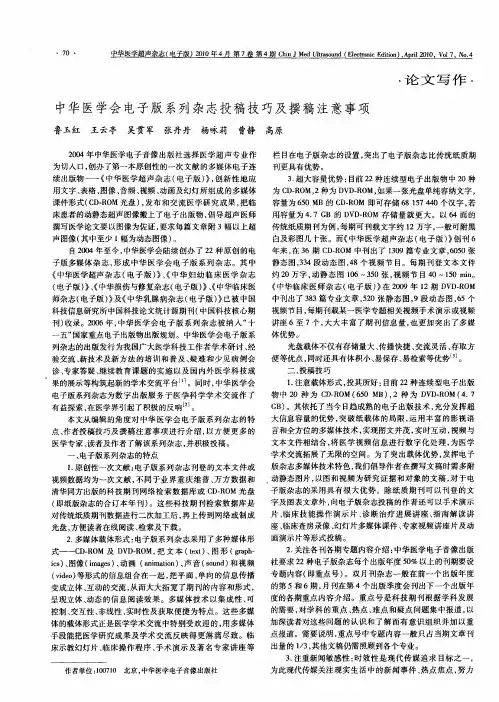
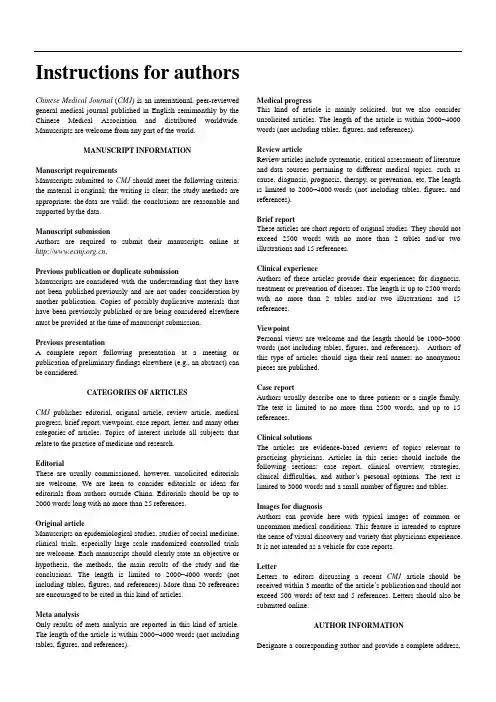
Instructions for authorsChinese Medical Journal (CMJ) is an international, peer-reviewed general medical journal published in English semimonthly by the Chinese Medical Association and distributed worldwide. Manuscripts are welcome from any part of the world.MANUSCRIPT INFORMATIONManuscript requirementsManuscripts submitted to CMJ should meet the following criteria: the material is original; the writing is clear; the study methods are appropriate; the data are valid; the conclusions are reasonable and supported by the data.Manuscript submissionAuthors are required to submit their manuscripts online at .Previous publication or duplicate submissionManuscripts are considered with the understanding that they have not been published previously and are not under consideration by another publication. Copies of possibly duplicative materials that have been previously published or are being considered elsewhere must be provided at the time of manuscript submission.Previous presentationA complete report following presentation at a meeting or publication of preliminary findings elsewhere (e.g., an abstract) can be considered.CATEGORIES OF ARTICLESCMJ publishes editorial, original article, review article, medical progress, brief report,viewpoint, case report, letter, and many other categories of articles. Topics of interest include all subjects that relate to the practice of medicine and research.EditorialThese are usually commissioned, however, unsolicited editorials are welcome. We are keen to consider editorials or ideas for editorials from authors outside China. Editorials should be up to 2000 words long with no more than 25 references.Original articleManuscripts on epidemiological studies, studies of social medicine, clinical trials, especially large scale randomized controlled trials are welcome. Each manuscript should clearly state an objective or hypothesis, the methods, the main results of the study and the conclusions. The length is limited to 2000–4000words (not including tables, figures, and references).More than 20 references are encouraged to be cited in this kind of articles.Meta analysisOnly results of meta analysis are reported in this kind of article. The length of the article is within 2000–4000 words (not including tables, figures, and references). Medical progressThis kind of article is mainly solicited, but we also consider unsolicited articles. The length of the article is within 2000–4000 words (not including tables, figures, and references).Review articleReview articles include systematic, critical assessments of literature and data sources pertaining to different medical topics, such as cause, diagnosis, prognosis, therapy, or prevention, etc.The length is limited to 2000–4000words (not including tables, figures, and references).Brief reportThese articles are short reports of original studies. They should not exceed 2500 words with no more than 2 tables and/or two illustrations and 15 references.Clinical experienceAuthors of these articles provide their experiences for diagnosis, treatment or prevention of diseases. The length is up to 2500 words with no more than 2 tables and/or two illustrations and 15 references.ViewpointPersonal views are welcome and the length should be 1000–3000 words (not including tables, figures, and references). Authors of this type of articles should sign their real names; no anonymous pieces are published.Case reportAuthors usually describe one to three patients or a single family. The text is limited to no more than 2500 words, and up to 15 references.Clinical solutionsThe articles are evidence-based reviews of topics relevant to practicing physicians. Articles in this series should include the following sections: case report, clinical overview, strategies, clinical difficulties, and author’s personal opinions. The text is limited to 3000 words and a small number of figures and tables. Images for diagnosisAuthors can provide here with typical images of common or uncommon medical conditions. This feature is intended to capture the sense of visual discovery and variety that physicians experience. It is not intended as a vehicle for case reports.LetterLetters to editors discussing a recent CMJ article should be received within 3 months of the article’s publication and should not exceed 500 words of text and 5 references. Letters should also be submitted online.AUTHOR INFORMATIONDesignate a corresponding author and provide a complete address,telephone and fax numbers, and E-mail address.Authorship requirementsEach author should have participated sufficiently in the work to take public responsibility for appropriate portions of the content. One or more authors should take responsibility for the integrity of the work as a whole, from inception to published article. Authorship credit should be based on(1) substantial contributions to conception and design, or acquisition of data, or analysis and interpretation of data; and (2) drafting the article or revising it critically for important intellectual content; and (3) final approval of the version to be published.Conditions 1, 2, and 3 must all be met.1Group authorshipIf authorship is attributed to a group, all members of the group must meet the full criteria and requirements for authorship as described above. A group must designate at least one individual as corresponding author. Other group members may be listed in an Acknowledgment.Conflicts of interestAuthors should indicate relevant conflicts of interest, including specific financial interests relevant to the subject of their manuscript, in their covering letter. Authors without relevant financial interests in the manuscript should indicate no such interest.EDITORIAL REVIEW AND PUBLICATIONPeer reviewA CMJ editor reviews submitted manuscripts initially. Manuscripts with insufficient priority for publication are rejected promptly. Other manuscripts are sent to expert consultants for peer review. Peer reviewer identities are kept confidential.The manuscript under review is not revealed to anyone other than peer reviewers and editorial staff. We encourage authors to suggest the names of possible reviewers, but we reserve the right of final selection. Rejected manuscriptsRejected manuscripts and reasons for rejection can be found online. EditingAccepted manuscripts are copyedited first by native speakers and then by CMJ editors according to CMJ style and returned to the author for approval. Authors are responsible for all statements made in their work, including changes made by the editor and authorized by the corresponding author.PublicationAuthors are required to pay page fee if their manuscripts are accepted for publication. The publisher will provide the author (s) 2 copies of the journal free of charge.CopyrightThe Chinese Medical Association (CMA) is the owner of all copyrights to any articles published in the journal. Published manuscripts become the permanent property of the Chinese Medical Association and may not be published elsewhere without written permission. Chinese Medical Association keeps the right to use these manuscripts in any form, including print, video, audio, and digital.MANUSCRIPT PREPARATIONManuscripts should be prepared in accordance with the Uniform Requirements for Manuscripts Submitted to Biomedical Journals by the International Committee of Medical Journal Editors (ICMJE) ().Submit the original manuscript online; use 1 side of standard-sized page and 1.5 cm margins.For Chinese authors, submission of a Chinese version of the manuscript (or abstract) is recommended.Use only 10- or 12-point font size.On the title page include the full names and affiliations of all authors. If an author’s affiliation has changed since the work was done, list the new affiliation as well. Titles should be concise and descriptive. The name, address, telephone number, fax number, and E-mail address of the correspondence author should be addressed. Any grant support that requires acknowledgment should be mentioned on this page.Measurements of length, height, weight, and volume should be reported in metric units (meter, kilogram, or liter) or their decimal multiples. Temperatures should be given in degrees Celsius. Blood pressures should be given in millimeters of mercury. All hematological and clinical chemistry measurements should be reported in the metric system in terms of the International System Units (SI).Use nonproprietary names of drugs, devices, and other products, unless the specific trade name of a drug is directly relevant to the discussion.Do not use abbreviations in the title or abstract and limit their use in the text.A covering letter signed by all authors includes(1) information on prior or duplicate publication or submission elsewhere of any part of the study; (2) the statement that the manuscript has been read and approved by all the authors and that the criteria for authorship have been met; (3) the statement on financial or other conflict of interests; and (4) any suggestions such as referring possible unqualified reviewers due to conflict of interests, etc. The corresponding author must sign the acknowledgment statement. Authors should obtain written permission from all individuals named in an acknowledgment.JOURNAL STYLETablesTables should be simple and no duplicate information should appear in the text of the article. Tables should be numbered consecutively, and headed by a concise title. Place explanatory matter in footnotes, not in the heading. Explain in footnotes all non-standard abbreviations that are used in each table. Forfootnotes use the following symbols in this sequence: *, †, ‡, §, ||, ¶, **, ††, ‡‡.FiguresComplete sets of illustrations must be submitted with legends typed on the same page. Only clear photographs are acceptable. All lettering must be legible after reduction to column size. Magnification and staining should be indicated when pertinent. AbbreviationsUse only standard abbreviations. Avoid abbreviations in the title and abstract. The full term for which an abbreviation stands should precede its first use in the text unless it is a standard unit of measurement.Ethical requirementFor experimental investigations of human subjects, state in the Methods section that an appropriate institutional review board approved the project. For those investigators who do not have formal ethics review committees,the principles outlined in the Declaration of Helsinki2 should be followed. For investigations of human subjects, state in the Methods section the manner in which informed consent was obtained from the study participants.Patient descriptions, photographs, and pedigreesInclude a signed statement of informed consent to publish (in print and online) patient descriptions, photographs, and pedigrees from all persons (parents or legal guardians for minors) who can be identified in such written descriptions, photographs, or pedigrees. Such persons should be shown the manuscript before its submission.Permissions required to reproduce or adapt material Acknowledge all text, illustrations, and tables adapted or reproduced from other publications and submit permission from the original publishers(or other copyright owner) to republish in print, online, and licensed versions of CMJ.ReferencesNumber references in the order they appear in the text; do not alphabetize. In text, tables, and legends, identify references with superscript Arabic numerals. When listing references,abbreviate titles of journals according to Medline. Note: List authors and/or editors up to 6; if more than 6, list the first 6 authors followed by et al.Examples of reference style:1. Liu XP, Long DY, Dong JZ, Liu XQ, Fang DP, Hao P, et al. Recurrent atrial tachycardia and atrial fibrillation after circumferential pulmonary vein a blation: What’s the difference? Chin Med J 2005; 118: 1773-1778.2. Xie SZ, Gu MJ, Cheng YP. Inhibitory effect of medroxyprogesterone acetate on angiogenesis induced by malignant neoplasm. Chin J Obstet Gynecol (Chin)* 1998; 33: 113-114.3. Weinstein L, Swartz MN. Pathogenic properties of invading microorganisms. In: Sodeman WA Jr., Sodeman WA, eds. Pathologic physiology: mechanisms of disease. Philadelphia: Saunders; 1974: 457-472.4. Dannenberg AM. Immune mechanisms in the pathogenesis of pulmonary tuberculosis. Rev Infect Dis 1989; 11 Suppl 2: s369-s378.5. Payne DK, Sullivan MD, Massie MJ. Women’s psychological reactions to breast cancer. Semin Oncol 1996; 23(1 Suppl 2): 89-97.6. Ozben T, Nacitarhan S, Tuncer N. Plasma and urine sialic acid in non-insulin dependent diabetes mellitus. Ann Clin Biochem 1995;32 (Pt 3): 303-306.7. Turan I, Wredmark T, Fellander-Tsai L. Arthroscopic ankle arthrodesis in rheumatoid arthritis. Clin Orthop 1995; (320): 110-114.8. Cumulative number of reported cases of severe acute respiratory syndrome (SARS). Geneva: World Health Organization, 2003. (Accessed April 9, 2003 at http://www.who.int/csr/sarscountry/ 2003_04_04/en/.)*: It is especially needed to note “(Chin)” for articles published in Chinese.Authors are responsible for the accuracy and completeness of their references and for correct citation of the text.REPORT OF ORIGINAL DATAAbstractInclude a structured abstract of no more than 300words for original articles, meta analysis, brief report, clinical experience (Background, Methods, Results, Conclusions) and review articles (Objective, Data sources, Study selection, Results, Conclusions); an informative abstract for medical progress, viewpoint, case report, clinical solutions and images for diagnosis.KeywordsThree to 6 words or short phrases should be provided at the top of the abstract page as keywords. Terms from the medical subject heading (MeSH) list of Medline should be used; if suitable MeSH terms are not yet available for recently introduced terms, present terms may be used.IntroductionIntroduction should be short and arresting. State the purpose of the article and summarize the rationale for the study or observation. Give only strictly pertinent references and do not include data or conclusions from the work being reported.MethodsDescribe your selection of the observational or experimental subjects (patients or laboratory animals, including controls) clearly. Identify the age, sex, and other important characteristics of the subjects.Iden tify the methods, apparatus (list the manufacturer’s name and original country in parentheses), and procedures in sufficient detail to allow other workers to reproduce the results. Give references to established methods, including statistical methods; provide references and brief descriptions for methods that have been published but are not well known; describe new or substantially modified methods, give reasons for using them, and evaluate theirlimitations. Identify precisely all drugs and chemicals used, including generic name (s), dose (s), and route (s) of administration.Reports of randomized clinical trials should present information on all major study elements including the protocol (study population, interventions or exposures, outcomes, and the rationale for statistical analysis), assignment of interventions (methods of randomization, concealment of allocation to treatment groups), and the method of masking (blinding). Authors are recommended to refer to the CONSORT Statement 3 for details.ResultsOverall describe the major findings of the study. Present your results in logical sequence in the text, tables and illustrations. Do not repeat in the text all the data in the tables or illustrations; emphasize or summarize only important observations. DiscussionSummarize the major findings. Discuss possible problems with the methods used. Compare your results with previous work. Discuss the clinical and scientific (if any) implications of your findings and their limitations. Suggest further work. Produce a succinct conclusion.MANUSCRIPT CHECKLISTSubmit complete text of your manuscript online (including tables, figures, etc), in addition, domestic authors should submit Chinese version of the complete text or its abstract.Review the sequence: covering letter, title page, key words and abstract, text, acknowledgments, references, tables, legends for illustrations.Check all references for accuracy and completeness. Put references in proper format in numerical order, making sure each is cited in the text.Include written permission from each individual identified as a source for personal communication.Include informed consent forms for identifiable patient descriptions, photographs and pedigrees.Keep copies of everything submitted.Manuscript inquiriesTel:86-10-85158321.Fax:86-10-85158333.Email:***********. cn.REFERENCES1.International Committee of Medical Journal Editors. Uniformrequirements for manuscripts submitted to biomedical journals.(Accessed September 10, 2009 at: )2.World Medical Association. Declaration of Helsinki: Ethicalprinciples for medical research involving human subjects.(Accessed September 6, 2005 at: /e/policy/ pdf/ 17c.pdf)3.Schulz KF, Altman DG, Moher D, for the CONSORT Group.The CONSORT statement: revised recommendations for improving the quality of reports of parallel-group randomized trials. (Accessed October 28, 2010 at: http://www.consort- )。

《中华医学》杂志投稿须知《中华医学杂志》简介《中华医学杂志》(ISSN 0376-2491, CN 11-2137/R)创刊于中华医学会成立的1915年。
创刊之初是中、英文双语期刊,英文刊名为National Medical Journal of China。
1932年,《中华医学杂志》的英文部分与中国博医会的英文杂志China Medical Journal (博医会报)合并,以Chinese Medical Journal为刊名出版;中文部分仍称《中华医学杂志》继续出版,并继续保留National Medical Journal of China的英文刊名,现在,在中华医学杂志的论著类文章中依然保留英文的作者姓名、通讯地址和严格的英文摘要。
作为中国卫生部中华医学会的会刊、中华医学会主办的一木医学综合性学术期刊,中华医学杂志创刊90年来始终坚持以服务广大会员和医药卫生科技人员、促进国内外医学学术交流和医学事业发展为宗旨,全面反映中国医学最新的科研成果,紧密跟踪世界医学科技进步的潮流,理论与实践结合,提高与普及并重,积极推广医药卫生领域的新技术、新成果,及时交流防病治病的新经验,大力普及医学科技新知识,为提高中国广大医药卫生人员的思想和职业道德修养、医学科学理论和业务技术水平,推动中国医学科技进步和知识创新,以及繁荣中国医学科技出版事业,发挥了重要作用。
历经数代人的努力,《中华医学杂志》形成了科学性强、权威度高、影响力大、覆盖面广的刊物特色,树立了良好的社会形象,在中国医学界享有很高的声誉。
中国国家图书馆、中国科技信息研究所、中国医学科学院科技信息研究所、中国科学文献计量评价研究中心等国家科技信息情报部门均把中华医学杂志列为核心期刊。
据中国科技论文与引文数据库和中国科学引文数据库提供的资料,中华医学杂志的被引频次连续数年在中国医学期刊中位居前十名(由《中国科技期刊引证报告》,2003年是医学类第五名,2004年是医学类第三名),影响因子连续五年呈上升趋势,在综合类医学期刊中始终位居前五名(由《中国科技期刊引证报告》,1992年和1996 2003年是医学综合类第三名,2004年是医学综合类第四名)O年,中华医学杂志分别荣获首届和第二届全国优秀科技期刊一等奖;1999年荣获首届国家期刊奖;2002年荣获第二届国家期刊奖,2004年荣获第三届国家期刊奖,连续四年荣获中国百种杰出学术期刊称号。
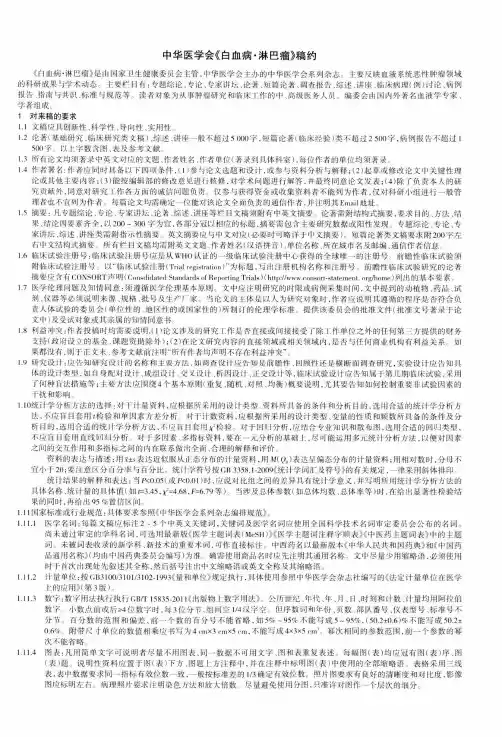
中华医学会《白血病•淋巴瘤》稿约《白血病•淋巴瘤》是由W家卫生健康委员会主管,中华医学会主办的中华医学会系列杂志。
主要反映血液系统恶性肿瘤领域的科研成果与学术动态。
主要栏目有:专题综论、专论,专家讲坛、论著、短篇论著,调查报告、综述、讲座、临床病理(例)讨论、病例报告、指南与共识、标准与规范等。
读者对象为从事肿瘤研究和临床工作的中、高级医务人员。
编委会由国内外著名血液学专家、学者组成。
1对来稿的要求I.I文稿应具创新性、科学性、导向性、实用性。
1.2论著(基础研究、临床研究类文稿)、综述、讲座一般不超过5 000字,短篇论著(临床经验)类不超过2 500字,病例报告不超过1500字。
以上字数含图、表及参考文献:1.3所有论文均须著录中英文对应的文题、作者姓名、作者单位(著录到具体科室),每位作者的单位均须著录。
1.4作者署名:作者应同时具备以下四项条件,(1)参与论文选题和设计,或参与资料分析与解释;(2)起草或修改论文中关键性理论或其他主要内容;(3)能按编辑部的修改意见进行核修,对学术问题进行解答,并最终同意论文发表;(4)除了负责本人的研 究贡献外,同意对研究丁.作各方面的诚信问题负责:仅参与获得资金或收集资料者不能列为作者,仅对科研小组进行一般管 理者也不宜列为作者。
每篇论文均需确定一位能对该论文全面负责的通信作者,并注明其Email地址。
1.5摘要:凡专题综论、专论、专家讲坛、论著、综述、讲座等栏目文稿须附有中英文摘要。
论著需附结构式摘要,要求目的、方法、结果、结论四要素齐全,以200 ~ 300字为宜,各部分冠以相应的标题,摘要需包含主要研究数据或阳性发现:专题综论、专论、专 家讲坛、综述、讲座类需附指示性摘要。
英文摘要应与中文对应(必要时可略详于中文摘要)。
短篇论著类文稿要求附200字左 右中文结构式摘要。
所有栏目文稿均需附英文文题、作者姓名(汉语拼音)、单位名称、所在城市名及邮编、通信作者信息。
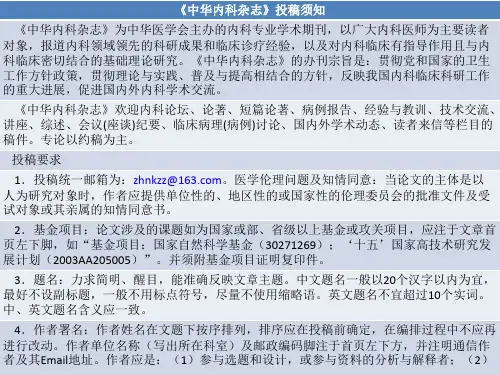
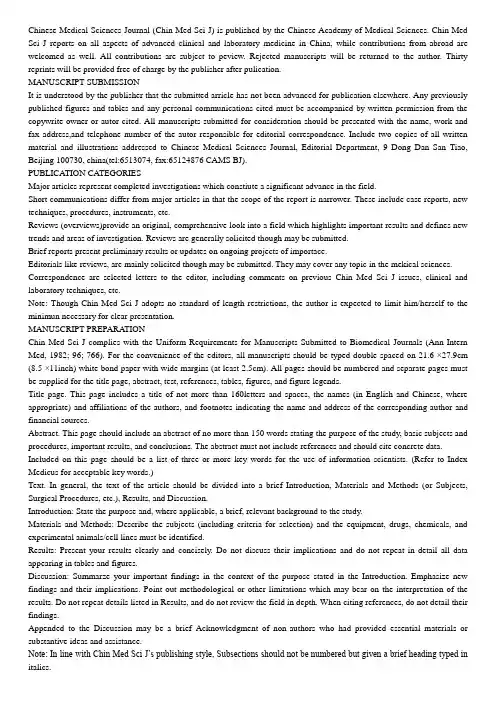
Chinese Medical Sciences Journal (Chin Med Sci J) is published by the Chinese Academy of Medical Sciences. Chin Med Sci J reports on all aspects of advanced clinical and laboratory medicine in China, while contributions from abroad are welcomed as well. All contributions are subject to peview. Rejected manuscripts will be returned to the author. Thirty reprints will be provided free of charge by the publisher after pulication.MANUSCRIPT SUBMISSIONIt is understood by the publisher that the submitted arricle has not been advanced for publication elsewhere. Any previously published figures and tables and any personal communications cited must be accompanied by written permission from the copywrite owner or autor cited. All manuscripts submitted for consideration should be presented with the name, work and fax address,and telephone number of the autor responsible for editorial correspondence. Include two copies of all written material and illustrations addressed to Chinese Medical Sciences Journal, Editorial Department, 9 Dong Dan San Tiao, Beijing 100730, china(tel:6513074, fax:65124876 CAMS BJ).PUBLICATION CATEGORIESMajor articles represent completed investigations which constiute a significant advance in the field.Short communications differ from major articles in that the scope of the report is narrower. These include case reports, new techniques, procedures, instruments, etc.Reviews (overviews)provide an original, comprehensive look into a field which highlights important results and defines new trends and areas of investigation. Reviews are generally solicited though may be submitted.Brief reports present preliminary results or updates on ongoing projects of importace.Editorials like reviews, are mainly solicited though may be submitted. They may cover any topic in the mekical sciences. Correspondence are selected letters to the editor, including comments on previous Chin Med Sci J issues, clinical and laboratory techniques, etc.Note: Though Chin Med Sci J adopts no standard of length restrictions, the author is expected to limit him/herself to the minimun necessary for clear presentation.MANUSCRIPT PREPARATIONChin Med Sci J complies with the Uniform Requirements for Manuscripts Submitted to Biomedical Journals (Ann Intern Med, 1982; 96; 766). For the convenience of the editors, all manuscripts should be typed double-spaced on 21.6 ×27.9cm (8.5 ×11inch) white bond paper with wide margins (at least 2.5cm). All pages should be numbered and separate pages must be supplied for the title page, abstract, test, references, tables, figures, and figure legends.Title page. This page includes a title of not more than 160letters and spaces, the names (in English and Chinese, where appropriate) and affiliations of the authors, and footnotes indicating the name and address of the corresponding author and financial sources.Abstract. This page should include an abstract of no more than 150 words stating the purpose of the study, basic subjects and procedures, important results, and conclusions. The abstract must not include references and should cite concrete data. Included on this page should be a list of three or more key words for the use of information scientists. (Refer to Index Medicus for acceptable key words.)Text. In general, the text of the article should be divided into a brief Introduction, Materials and Methods (or Subjects, Surgical Procedures, etc.), Results, and Discussion.Introduction: State the purpose and, where applicable, a brief, relevant background to the study.Materials and Methods: Describe the subjects (including criteria for selection) and the equipment, drugs, chemicals, and experimental animals/cell lines must be identified.Results: Present your results clearly and concisely. Do not discuss their implications and do not repeat in detail all data appearing in tables and figures.Discussion: Summarze your important findings in the context of the purpose stated in the Introduction. Emphasize new findings and their implications. Point out methodological or other limitations which may bear on the interpretation of the results. Do not repeat details listed in Results, and do not review the field in depth. When citing references, do not detail their findings.Appended to the Discussion may be a brief Acknowledgment of non-authors who had provided essential materials or substantive ideas and assistance.Note: In line with Chin Med Sci J’s publishing style, Subsections should not be numbered but given a brief heading typed in italics.References. Chin Med Sci J limits references to 15 per article numbered in order of citation in the text. For reference form, see Annals of Internal Medicine 1982; 96:766.Examples of the proper format are:After HJ, et al. Clinical and serological analysis of transfusion associated hepatitis. Lancet, 1975; 2:838.Krieger DT. Plasma ACTH and corticosteroids. In: Degroot A, et al (eds). Endocrinology. Vol.2, New York: Grune and Stratton, 1979; 1139.References from Chinese journals must be translated into English.Tables and figures. These should be numbered in order of appearance.Tables: Data should be arranged clearly and concisely. Footnotes should be kept to a minimum (Acceptable symbols are*,**, etc.). Columns must be provided with headings and units. Do not use vertical rules.Figures: Including graphs, flow charts, diagrams and photographs, figures should be clear, 7×9cm in size. In the case of photographs, the orientation of each print (glossy) should be indicated on the reverse.Figure legends: Clearly explain each symbol appearing in the respective table of figure. In the case of photomicrographs, indicate the staining method and magnification.Units of measurement. In tables, figures, and throughout the text, data should be presented in metric units, temperature in degrees Celcius, blood pressure in Pascals (kPa), and the System International measurements(SI) (Ann Intern Med, 1987; 106:114-129) should be adopted as standard.地址:北京东单三条九号邮政编码:100730电话:65295931传真:65133074电子邮件:actacams@中国医学科学杂志(中华医学科学J)是由医疗发表中国科学院。

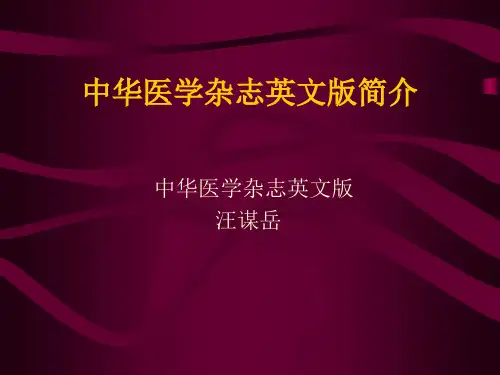
Instructions for authorsChinese Medical Journal (CMJ) is an international, peer-reviewed general medical journal published in English semimonthly by the Chinese Medical Association and distributed worldwide. Manuscripts are welcome from any part of the world.MANUSCRIPT INFORMATIONManuscript requirementsManuscripts submitted to CMJ should meet the following criteria: the material is original; the writing is clear; the study methods are appropriate; the data are valid; the conclusions are reasonable and supported by the data.Manuscript submissionAuthors are required to submit their manuscripts online at .Previous publication or duplicate submissionManuscripts are considered with the understanding that they have not been published previously and are not under consideration by another publication. Copies of possibly duplicative materials that have been previously published or are being considered elsewhere must be provided at the time of manuscript submission.Previous presentationA complete report following presentation at a meeting or publication of preliminary findings elsewhere (e.g., an abstract) can be considered.CATEGORIES OF ARTICLESCMJ publishes editorial, original article, review article, medical progress, brief report,viewpoint, case report, letter, and many other categories of articles. Topics of interest include all subjects that relate to the practice of medicine and research.EditorialThese are usually commissioned, however, unsolicited editorials are welcome. We are keen to consider editorials or ideas for editorials from authors outside China. Editorials should be up to 2000 words long with no more than 25 references.Original articleManuscripts on epidemiological studies, studies of social medicine, clinical trials, especially large scale randomized controlled trials are welcome. Each manuscript should clearly state an objective or hypothesis, the methods, the main results of the study and the conclusions. The length is limited to 2000–4000words (not including tables, figures, and references).More than 20 references are encouraged to be cited in this kind of articles.Meta analysisOnly results of meta analysis are reported in this kind of article. The length of the article is within 2000–4000 words (not including tables, figures, and references). Medical progressThis kind of article is mainly solicited, but we also consider unsolicited articles. The length of the article is within 2000–4000 words (not including tables, figures, and references).Review articleReview articles include systematic, critical assessments of literature and data sources pertaining to different medical topics, such as cause, diagnosis, prognosis, therapy, or prevention, etc.The length is limited to 2000–4000words (not including tables, figures, and references).Brief reportThese articles are short reports of original studies. They should not exceed 2500 words with no more than 2 tables and/or two illustrations and 15 references.Clinical experienceAuthors of these articles provide their experiences for diagnosis, treatment or prevention of diseases. The length is up to 2500 words with no more than 2 tables and/or two illustrations and 15 references.ViewpointPersonal views are welcome and the length should be 1000–3000 words (not including tables, figures, and references). Authors of this type of articles should sign their real names; no anonymous pieces are published.Case reportAuthors usually describe one to three patients or a single family. The text is limited to no more than 2500 words, and up to 15 references.Clinical solutionsThe articles are evidence-based reviews of topics relevant to practicing physicians. Articles in this series should include the following sections: case report, clinical overview, strategies, clinical difficulties, and author’s personal opinions. The text is limited to 3000 words and a small number of figures and tables. Images for diagnosisAuthors can provide here with typical images of common or uncommon medical conditions. This feature is intended to capture the sense of visual discovery and variety that physicians experience. It is not intended as a vehicle for case reports.LetterLetters to editors discussing a recent CMJ article should be received within 3 months of the article’s publication and should not exceed 500 words of text and 5 references. Letters should also be submitted online.AUTHOR INFORMATIONDesignate a corresponding author and provide a complete address,telephone and fax numbers, and E-mail address.Authorship requirementsEach author should have participated sufficiently in the work to take public responsibility for appropriate portions of the content. One or more authors should take responsibility for the integrity of the work as a whole, from inception to published article. Authorship credit should be based on(1) substantial contributions to conception and design, or acquisition of data, or analysis and interpretation of data; and (2) drafting the article or revising it critically for important intellectual content; and (3) final approval of the version to be published.Conditions 1, 2, and 3 must all be met.1Group authorshipIf authorship is attributed to a group, all members of the group must meet the full criteria and requirements for authorship as described above. A group must designate at least one individual as corresponding author. Other group members may be listed in an Acknowledgment.Conflicts of interestAuthors should indicate relevant conflicts of interest, including specific financial interests relevant to the subject of their manuscript, in their covering letter. Authors without relevant financial interests in the manuscript should indicate no such interest.EDITORIAL REVIEW AND PUBLICATIONPeer reviewA CMJ editor reviews submitted manuscripts initially. Manuscripts with insufficient priority for publication are rejected promptly. Other manuscripts are sent to expert consultants for peer review. Peer reviewer identities are kept confidential.The manuscript under review is not revealed to anyone other than peer reviewers and editorial staff. We encourage authors to suggest the names of possible reviewers, but we reserve the right of final selection. Rejected manuscriptsRejected manuscripts and reasons for rejection can be found online. EditingAccepted manuscripts are copyedited first by native speakers and then by CMJ editors according to CMJ style and returned to the author for approval. Authors are responsible for all statements made in their work, including changes made by the editor and authorized by the corresponding author.PublicationAuthors are required to pay page fee if their manuscripts are accepted for publication. The publisher will provide the author (s) 2 copies of the journal free of charge.CopyrightThe Chinese Medical Association (CMA) is the owner of all copyrights to any articles published in the journal. Published manuscripts become the permanent property of the Chinese Medical Association and may not be published elsewhere without written permission. Chinese Medical Association keeps the right to use these manuscripts in any form, including print, video, audio, and digital.MANUSCRIPT PREPARATIONManuscripts should be prepared in accordance with the Uniform Requirements for Manuscripts Submitted to Biomedical Journals by the International Committee of Medical Journal Editors (ICMJE) ().Submit the original manuscript online; use 1 side of standard-sized page and 1.5 cm margins.For Chinese authors, submission of a Chinese version of the manuscript (or abstract) is recommended.Use only 10- or 12-point font size.On the title page include the full names and affiliations of all authors. If an author’s affiliation has changed since the work was done, list the new affiliation as well. Titles should be concise and descriptive. The name, address, telephone number, fax number, and E-mail address of the correspondence author should be addressed. Any grant support that requires acknowledgment should be mentioned on this page.Measurements of length, height, weight, and volume should be reported in metric units (meter, kilogram, or liter) or their decimal multiples. Temperatures should be given in degrees Celsius. Blood pressures should be given in millimeters of mercury. All hematological and clinical chemistry measurements should be reported in the metric system in terms of the International System Units (SI).Use nonproprietary names of drugs, devices, and other products, unless the specific trade name of a drug is directly relevant to the discussion.Do not use abbreviations in the title or abstract and limit their use in the text.A covering letter signed by all authors includes(1) information on prior or duplicate publication or submission elsewhere of any part of the study; (2) the statement that the manuscript has been read and approved by all the authors and that the criteria for authorship have been met; (3) the statement on financial or other conflict of interests; and (4) any suggestions such as referring possible unqualified reviewers due to conflict of interests, etc. The corresponding author must sign the acknowledgment statement. Authors should obtain written permission from all individuals named in an acknowledgment.JOURNAL STYLETablesTables should be simple and no duplicate information should appear in the text of the article. Tables should be numbered consecutively, and headed by a concise title. Place explanatory matter in footnotes, not in the heading. Explain in footnotes all non-standard abbreviations that are used in each table. Forfootnotes use the following symbols in this sequence: *, †, ‡, §, ||, ¶, **, ††, ‡‡.FiguresComplete sets of illustrations must be submitted with legends typed on the same page. Only clear photographs are acceptable. All lettering must be legible after reduction to column size. Magnification and staining should be indicated when pertinent. AbbreviationsUse only standard abbreviations. Avoid abbreviations in the title and abstract. The full term for which an abbreviation stands should precede its first use in the text unless it is a standard unit of measurement.Ethical requirementFor experimental investigations of human subjects, state in the Methods section that an appropriate institutional review board approved the project. For those investigators who do not have formal ethics review committees,the principles outlined in the Declaration of Helsinki2 should be followed. For investigations of human subjects, state in the Methods section the manner in which informed consent was obtained from the study participants.Patient descriptions, photographs, and pedigreesInclude a signed statement of informed consent to publish (in print and online) patient descriptions, photographs, and pedigrees from all persons (parents or legal guardians for minors) who can be identified in such written descriptions, photographs, or pedigrees. Such persons should be shown the manuscript before its submission.Permissions required to reproduce or adapt material Acknowledge all text, illustrations, and tables adapted or reproduced from other publications and submit permission from the original publishers(or other copyright owner) to republish in print, online, and licensed versions of CMJ.ReferencesNumber references in the order they appear in the text; do not alphabetize. In text, tables, and legends, identify references with superscript Arabic numerals. When listing references,abbreviate titles of journals according to Medline. Note: List authors and/or editors up to 6; if more than 6, list the first 6 authors followed by et al.Examples of reference style:1. Liu XP, Long DY, Dong JZ, Liu XQ, Fang DP, Hao P, et al. Recurrent atrial tachycardia and atrial fibrillation after circumferential pulmonary vein a blation: What’s the difference? Chin Med J 2005; 118: 1773-1778.2. Xie SZ, Gu MJ, Cheng YP. Inhibitory effect of medroxyprogesterone acetate on angiogenesis induced by malignant neoplasm. Chin J Obstet Gynecol (Chin)* 1998; 33: 113-114.3. Weinstein L, Swartz MN. Pathogenic properties of invading microorganisms. In: Sodeman WA Jr., Sodeman WA, eds. Pathologic physiology: mechanisms of disease. Philadelphia: Saunders; 1974: 457-472.4. Dannenberg AM. Immune mechanisms in the pathogenesis of pulmonary tuberculosis. Rev Infect Dis 1989; 11 Suppl 2: s369-s378.5. Payne DK, Sullivan MD, Massie MJ. Women’s psychological reactions to breast cancer. Semin Oncol 1996; 23(1 Suppl 2): 89-97.6. Ozben T, Nacitarhan S, Tuncer N. Plasma and urine sialic acid in non-insulin dependent diabetes mellitus. Ann Clin Biochem 1995;32 (Pt 3): 303-306.7. Turan I, Wredmark T, Fellander-Tsai L. Arthroscopic ankle arthrodesis in rheumatoid arthritis. Clin Orthop 1995; (320): 110-114.8. Cumulative number of reported cases of severe acute respiratory syndrome (SARS). Geneva: World Health Organization, 2003. (Accessed April 9, 2003 at http://www.who.int/csr/sarscountry/ 2003_04_04/en/.)*: It is especially needed to note “(Chin)” for articles published in Chinese.Authors are responsible for the accuracy and completeness of their references and for correct citation of the text.REPORT OF ORIGINAL DATAAbstractInclude a structured abstract of no more than 300words for original articles, meta analysis, brief report, clinical experience (Background, Methods, Results, Conclusions) and review articles (Objective, Data sources, Study selection, Results, Conclusions); an informative abstract for medical progress, viewpoint, case report, clinical solutions and images for diagnosis.KeywordsThree to 6 words or short phrases should be provided at the top of the abstract page as keywords. Terms from the medical subject heading (MeSH) list of Medline should be used; if suitable MeSH terms are not yet available for recently introduced terms, present terms may be used.IntroductionIntroduction should be short and arresting. State the purpose of the article and summarize the rationale for the study or observation. Give only strictly pertinent references and do not include data or conclusions from the work being reported.MethodsDescribe your selection of the observational or experimental subjects (patients or laboratory animals, including controls) clearly. Identify the age, sex, and other important characteristics of the subjects.Iden tify the methods, apparatus (list the manufacturer’s name and original country in parentheses), and procedures in sufficient detail to allow other workers to reproduce the results. Give references to established methods, including statistical methods; provide references and brief descriptions for methods that have been published but are not well known; describe new or substantially modified methods, give reasons for using them, and evaluate theirlimitations. Identify precisely all drugs and chemicals used, including generic name (s), dose (s), and route (s) of administration.Reports of randomized clinical trials should present information on all major study elements including the protocol (study population, interventions or exposures, outcomes, and the rationale for statistical analysis), assignment of interventions (methods of randomization, concealment of allocation to treatment groups), and the method of masking (blinding). Authors are recommended to refer to the CONSORT Statement 3 for details.ResultsOverall describe the major findings of the study. Present your results in logical sequence in the text, tables and illustrations. Do not repeat in the text all the data in the tables or illustrations; emphasize or summarize only important observations. DiscussionSummarize the major findings. Discuss possible problems with the methods used. Compare your results with previous work. Discuss the clinical and scientific (if any) implications of your findings and their limitations. Suggest further work. Produce a succinct conclusion.MANUSCRIPT CHECKLISTSubmit complete text of your manuscript online (including tables, figures, etc), in addition, domestic authors should submit Chinese version of the complete text or its abstract.Review the sequence: covering letter, title page, key words and abstract, text, acknowledgments, references, tables, legends for illustrations.Check all references for accuracy and completeness. Put references in proper format in numerical order, making sure each is cited in the text.Include written permission from each individual identified as a source for personal communication.Include informed consent forms for identifiable patient descriptions, photographs and pedigrees.Keep copies of everything submitted.Manuscript inquiriesTel:86-10-85158321.Fax:86-10-85158333.Email:***********. cn.REFERENCES1.International Committee of Medical Journal Editors. Uniformrequirements for manuscripts submitted to biomedical journals.(Accessed September 10, 2009 at: )2.World Medical Association. Declaration of Helsinki: Ethicalprinciples for medical research involving human subjects.(Accessed September 6, 2005 at: /e/policy/ pdf/ 17c.pdf)3.Schulz KF, Altman DG, Moher D, for the CONSORT Group.The CONSORT statement: revised recommendations for improving the quality of reports of parallel-group randomized trials. (Accessed October 28, 2010 at: http://www.consort- )。
论文投稿技巧论文投稿技巧1、投稿前,先在中国期刊网、维普科技期刊,图书馆《期刊园地-投稿指南》上查询一下期刊的合法性、正规性、级别,避免误投非法出版物。
2、可以先根据期刊提供的邮箱从网上投稿,合法期刊一般会回复要求你寄稿件的软盘、审稿费、单位介绍信等,部分期刊要求第一作者简介。
切记:未回复者尽量不要再投稿。
寄稿时一定按杂志社要求做,否则补寄资料就会耽误论文发表时间。
3、有时你会莫名其妙收到约稿,或论文发表通知书,要求你寄版面费,读者一定要慎重对待,建议不要在这样的刊物上发表论文,这样的刊物一般都是非法出版物。
一旦你在这样的杂志上发表了论文,也算公开发表,既不能在其他正规刊物上再次发表,又损失了钱,白白浪费一篇论文。
4、一般往核心期刊和统计源系列期刊投稿有一定的难度或时间较长,这些期刊审稿较为严格,所以建议也可以把稿件投到相关的边缘杂志。
5、投稿前最好先看一下欲投期刊近几期发表过的论文,因为很多杂志发表论文有共性,即每期重点或集中发表某主题的文章,且有周期性,一旦你的论文内容相关主题刚刚发表不久,暂时不要投稿,除非你的论文独特、新颖、实用性强,否则要等到下一个周期才有可能发表(一般半年到一年左右)。
7、一旦收到稿件修改通知,只要按照编辑要求修改,发表的可能性在95%以上,可以先询问稿件发表的版面费,可以在寄修改搞的同时把版面费一同寄去(事先最好电话联系),以免等收到发表通知后寄版面费耽误时间,编辑在收到版面费后可能会帮你进一步修改以便发表。
8、会议上发表的论文属于内部交流,可以在修改后再投寄到期刊上发表。
9、有知名学者指导的论文一定要加以说明,或署名第2作者,这样发表的机会最大。
10、如果是参加了国家自然基金、省基金或其他纵向科研课题项目,应标注在文章上,以证实文章的价值。
科技论文投稿的策略及建议科技论文投稿的策略及建议--------------------------------------------------------------------------------分开层次。
中华医学会中国医学系列杂志编排格式要求【精品推荐-doc】中国行为医学科学杂志编排格式1 引言1.1为统一中华医学会主办的期刊的编排格式,加强期刊的编辑规范化和科学管理,特制定本要求。
自2004年第1期起实行。
国外医学系列杂志除综述和文摘另有要求外,尽可能执行本要求。
1.2国家颁布的GB,T3179-92《科学技术期刊编排格式》,以及其他有关国家标准,本会期刊均应参照执行。
本要求依据国家标准,并结合本会期刊的实际情况,制定或补充更具体的要求。
1.3本要求仅就主要编排格式作了规定,其中大部分条款为统一要求,希望各编辑部认真执行。
本要求中提供了选择项的项目,或本要求中未提到的项目,其编排格式可由各编辑部自行决定,但要注意本刊的各期格式应保持一致。
2 开本采用大16开本,但根据期刊用纸情况的不同,允许?5mm差异。
3 封面封面自上而下依次排印中国标准刊号(右上角),“中华医学会系列杂志”字样,中文刊名,汉语拼音刊名,中文出版年月、卷序、期序,英文刊名,英文卷序、期序、出版年月,中华医学会会徽,中华医学会中、英文会名,条形码(左下角)。
左侧35mm宽的深色块内排中华医学会英文缩写CMA,国外医学系列杂志保留地球标识。
详见电子封面版本。
4 封二、封三、封四封二、封三、封四在广告来源充足的情况下均可以刊载广告。
没有广告的期刊,一般排目次表或本刊介绍或中华医学会系列杂志介绍或本刊稿约等。
每期封四底行均需列出中国标准刊号(由ISSN号和CN号组成)、邮发代号和国内定价。
示例如下(以中国地方病杂志为例):中国标准刊号:ISSN1000-4955 CN23-1276,R 邮发代号:14-30 国内定价:8:00元5 刊脊5.1平订期刊厚度大于或等于5mm时,应设计刊脊并排刊脊名称。
刊脊名称包括刊名、出版年月、卷序、期序和“中华医学会”字样。
刊名距上切口35mm,出版年月距刊名20mm,卷序距出版年月15mm,期序距卷序15mm,“中华医学会”字样距下切口20mm。
《中华医学杂志》简介
《中华医学杂志》( , ) 创刊于中华医学会成立的年。
创刊之初是中、英文双语期刊,英文刊名为。
年,《中华医学杂志》的英文部分与中国博医会的英文杂志(博医会报)合并,以为刊名出版;中文部分仍称《中华医学杂志》继续出版,并继续保留的英文刊名,现在,在中华医学杂志的论著类文章中依然保留英文的作者姓名、通讯地址和严格的英文摘要。
作为中国卫生部中华医学会的会刊、中华医学会主办的一本医学综合性学术期刊,中华医学杂志创刊年来始终坚持以服务广大会员和医药卫生科技人员、促进国内外医学学术交流和医学事业发展为宗旨,全面反映中国医学最新的科研成果,紧密跟踪世界医学科技进步的潮流,理论与实践结合,提高与普及并重,积极推广医药卫生领域的新技术、新成果,及时交流防病治病的新经验,大力普及医学科技新知识,为提高中国广大医药卫生人员的思想和职业道德修养、医学科学理论和业务技术水平,推动中国医学科技进步和知识创新,以及繁荣中国医学科技出版事业,发挥了重要作用。
历经数代人的努力,《中华医学杂志》形成了科学性强、权威度高、影响力大、覆盖面广的刊物特色,树立了良好的社会形象,在中国医学界享有很高的声誉。
中国国家图书馆、中国科技信息研究所、中国医学科学院科技信息研究所、中国科学文献计量评价研究中心等国家科技信息情报部门均把中华医学杂志列为核心期刊。
据中国科技论文与引文数据库和中国科学引文数据库提供的资料,中华医学杂志的被引频次连续数年在中国医学期刊中位居前十名(由《中国科技期刊引证报告》,年是医学类第五名,年是医学类第三名),影响因子连续五年呈上升趋势,在综合类医学期刊中始终位居前五名(由《中国科技期刊引证报告》,年是医学综合类第三名,年是医学综合类第四名)。
年和年,中华医学杂志分别荣获首届和第二届全国优秀科技期刊一等奖;年荣获首届国家期刊奖;年荣获第二届国家期刊奖年荣获第三届国家期刊奖,连续四年荣获中国百种杰出学术期刊称号。
在国际上,中华医学杂志于年被美国收录,年起就被美国医学会收录,是中国最早被国外医学索引收录的中文版医学期刊;年起被美国国立医学图书馆出版的收录,其后被该馆的联机检索系统收录;年起被荷兰及其数据库()收录;年起被俄罗斯Реферативный Журнал—РЖ 收录。
目前被国内外个数据库和检索系统收录,并与多个国家和地区的相关刊物建立了长期交换关系。
据《中国学术期刊综合评价数据库》的统计,中华医学杂志年来发表的论文在年间被国内种期刊引用了次;被的种源期刊引用了次。
《中华医学杂志》编辑委员会由生物医学领域的学科带头人组成。
自年成立第届编辑委员会,至今已历经届。
现任总编辑巴德年教授,是中国工程院院士。
在编委会的指导下,中华医学杂志的报道计划始终紧紧围绕中国医学科研攻关课题和严重危害广大人民健康的常见病、多发病的防治。
例如年中国爆发,中华医学杂志很快组织了多期研究的重点报道(月日第期,月日第期,月日第期,月日第期,月日第期等)。
同时,中华医学杂志也非常重视对影响中国医药卫生事业发展的重大问题的探讨。
例如,针对国内外临床抗感染治疗面临的棘手问题细菌耐药,中华医学杂志编辑委员会于和年分别组织召开了“细菌耐药与抗感染药物合理应用专题学术研讨会”,会上报道了中国全国范围内的细菌耐药现状调
查结果,表明中国大中城市细菌耐药的发展态势十分严峻,应引起政府有关部门和广大临床医师的高度重视。
中华医学杂志是国内外医学学术交流的重要园地,是为中国医学事业的发展提供精神动力和智力支持的坚强阵地。
稿约
一、投稿要求和注意事项
.来稿应具先进性、科学性和逻辑性。
要求资料真实、数据可靠、论点明确、结构严谨、文字通顺。
论著、综述等一般不超过字(不包括图表和参考文献),简报、病例报告等一般不超过字(不包括图表和参考文献)以文档的方式发至本刊邮箱。
.来稿须附单位推荐信。
推荐信应注明对稿件的审评意见以及无一稿两投、不涉及保密及署名无争议等项。
.来稿要求一式份,其中份为原稿,另份可为复印件,但照片不能用复印件,必须提供份原始照片。
文字应双倍行距打印。
特殊文种、上下角标符号、需排斜体等应予注明。
请自留底稿。
不采用稿件一般不寄还,但原始照片一律退还作者。
若需退还原稿,请在投稿时声明。
.来稿首页请标明以下内容:题名,每位作者的姓名、最高学历及工作单位,负责与编辑部联系的通讯作者的姓名及其详细通讯地址、电话号、传真号和地址,正文字数(不包括摘要、表、图和参考文献)、表数和图数。
.论文所涉及的课题若取得国家或部、省级以上基金资助或属攻关项目,请脚注于文题页左下方,如:“基金项目:国家自然科学基金资助项目();国家高技术研究发展计划资助项目()”,并请附基金证书复印件。
《中华医学杂志》为具有国际领先水平的创新性科研成果或国际首报论文开辟“快审通道”,凡要求以“快审通道”发表论文,作者应提供关于论文创新性的说明和查新报道。
经审核同意后,一般在收到稿件个月内刊出。
.作者在接到本刊回执后满个月未接到稿件处理通知,表明稿件仍在审阅中。
作者若欲投他刊,请先与本刊编辑部联系,切勿一稿两投。
一旦发现一稿两投,将立即退稿;而一旦发现一稿两用,《中华医学杂志》将刊登该文系重复发表的声明,并在年内拒绝以该文第一作者为作者的任何来稿。
.来稿一律文责自负。
根据《著作权法》,《中华医学杂志》对决定刊用的文稿可作文字修改、删节,凡有涉及原意的修改,则提请作者考虑。
对退修的文。